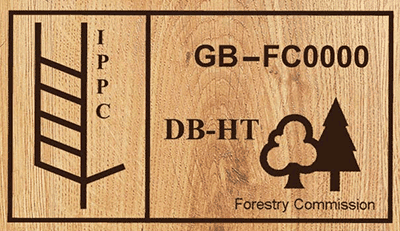International Standards for Phytosanitary Measures No. 15 (ISPM15) refers to an internationally recognised regulation regarding the heat treatment of wooden packaging.
Working within the logistics industry, you’ll need to be aware of and comply with ISPM15 regulations when transporting goods in and out of the UK. In this blog, we’ve collated all the important ISPM15 information you need to know into a simple guide. We’ve also created a downloadable PDF version, so you can save it, share it, and refer to it whenever you need a refresher.
What is ISPM15?
Implemented by the IPPC with the Food and Agriculture Organization of the United Nations (FAO), ISPM15 is the requirement for all wooden packaging (including wooden pallets, box pallets and pallet collars) to be heat treated when being used to transport goods internationally. This is to inhibit the risk of pests and other potential hazards that could have a major impact on a country’s local environment and biodiversity.
There are certain types of processed wood that are exempt from ISPM15 regulations, such as plywood. You can find out more information about what types of wood must meet this regulation via the Government website.
Which countries require ISPM15?
There is now a long list of countries that require ISPM15 compliance in order to import goods. The list is far too long to note here, so please do visit the IPPC website to find the most up-to-date record. It’s worth noting that many countries have additional requirements when it comes to wood packaging, so it’s important to familiarise yourself with a country’s individual requirements before importing goods there.
Why is heat treatment important for wooden pallets?
Wooden pallets in particular can be a breeding ground for pests, contaminants and diseases. Heat treatment is therefore a form of pest control and inhibits the risk of contaminants or diseases spreading to other countries. A good example of why ISPM regulations are important is the outbreak of the Asian longhorn beetle – a species which isn’t native to the UK, occurred as a result of infected wood packaging from China and resulted in hundreds of trees being destroyed.
In addition to pest and disease control, there are other benefits to heat treating wooden pallets. Heat treatment reduces a pallet’s moisture content, therefore making it less likely to rot, and be more sterile, durable and weatherproof.
How does heat treatment work?
The most conventional way to heat treat a pallet is by heating it to a minimum temperature of 56°C – or 60°C for hardwoods – for at least 30 minutes. However, other methods such as kiln drying and dielectric heating are also listed as possible treatments. Please note: MB (methyl bromide) is also listed as an alternative treatment but this has been banned in Europe since 2005 due to its environmental and health hazards; it is still used in other countries to tackle pests that can withstand heat treatments. You can find out more about this via our MB Stamped Pallets blog or via the IPPC/FAO guidance.
Contact us to out more about our heat treatment service.
What markings/stamps do heat treated pallets have?
Here is an example of the markings you can expect to see on a heat treated pallet:

The example shows three important markings:
- The IPPC logo.
- A geo-specific identifier (the first two letters indicate the country that the pallet originates from and the following digits are a regional identifier).
- A treatment stamp to show which type of treatment has been used.
Please do take the time to read through our Ultimate Guide To Pallet Markings where you’ll find further information and definitions regarding the different markings and treatment stamps.
Can heat treated pallets be reused once marked/stamped?
Yes, ISPM15 compliance lasts for the pallet’s entire lifespan; it doesn’t expire and won’t need to be retreated – unless the pallet goes through any maintenance or repair work, in which case the pallet should be retreated and rebranded.
How can I keep track of ISPM15 updates?
The best way to ensure you’re following the most up-to-date guidance is to keep an eye on the Government website.
Please do get in touch with us if you have any questions or concerns regarding ISPM15 regulations. We’re here to help. There’s also the official lSPM15 website where you’ll find an abundance of information and explanations. You can also browse through our online shop where you’ll find various ISPM15 heat treated pallets.
